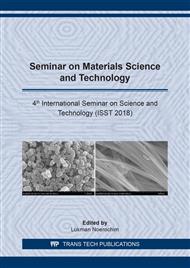[1]
Yunizal, K. Pengembangan pengolahan rumput laut. 2004. pp.9-12.
Google Scholar
[2]
Bixler, H.J. A decade of change in the seaweed hydrocolloids industry. Journal of Applied Phycology (2011) Volume 23, Issue 3, p.321–335.
DOI: 10.1007/s10811-010-9529-3
Google Scholar
[3]
Gerasimenko. Seasonal Changes in the Content of Lipids, Fatty Acids, and Pigments in Brown Alga Costaria costata. Russian Journal of Plant Physiology (2010) Volume 57, Issue 2, p.205–211.
DOI: 10.1134/s102144371002007x
Google Scholar
[4]
Atmadja, W.S., A., Kadi, Sulistijo dan R. Satari. Pengenalan Jenis-Jenis Rumput Laut Indonesia. Puslitbang. Jakarta. (2012).
Google Scholar
[5]
Derby, Basmal. Manufacture of biomaterials by a novel printing process. J. Mater. Sci. Mater. Med (2002) 1163–1166.
Google Scholar
[6]
Gomeza, C.G. Influence of the extraction–purification conditions on final properties of alginates brown algae. International Journal of Biological Macromolecules (2009). Volume 44, Issue 4, pp.365-371.
DOI: 10.1016/j.ijbiomac.2009.02.005
Google Scholar
[7]
Mutia, Theresia. Membran Alginat Sebagai Pembalut Luka Primer. Jurnal riset industry.2011. Vol 5, No 2 161-174.
DOI: 10.31266/at.v26i1.1438
Google Scholar
[8]
Anwar, Hina, . Alginate-Polyvinyl Alcohol Based IPN for Prolonged Drug Therapy. Carbohydrate polymer (2017) 183-194.
DOI: 10.1016/j.carbpol.2017.02.080
Google Scholar
[9]
Nasim, Golafshan. 2016. Tough and conductive hybrid graphene-PVA: Alginate fibrous scaffolds for neural construct. Carbon (2017) Volume 111, 2017, Pages 752-763.
DOI: 10.1016/j.carbon.2016.10.042
Google Scholar
[10]
Ye, Mao. Morphology and properties of polyvinyl alcohol (PVA) scaffolds: Impact of process variables. Mater Sci Eng C Mater Biol Appl. (2014) p.289–294.
Google Scholar
[11]
Seung-Taek Oh. The Effect of Bentonite Concentration on the Drug Delivery Efficacy of a pH-sensitive Alginate/Bentonite Hydrogel. Fibers and Polymers 2009, Vol.10, No.1, 21-26.
DOI: 10.1007/s12221-009-0021-0
Google Scholar
[12]
Luo, Yongxiang. 3D Bioprinting Scaffold Using Alginate/Polyvinyl Alcohol Bioinks. Materials Letters (2017) Volume 189, Pages 295-298.
DOI: 10.1016/j.matlet.2016.12.009
Google Scholar
[13]
P., Honghyun. Alginate hydrogels modified with low molecular weight hyaluronatefor cartilage regeneration. Carbohydr Polym. (2017) 162:100-107.
Google Scholar
[14]
K Fukushima, MH Wu, S Bocchini, A Rasyida, MC Yang. PBAT based nanocomposites for medical and industrial applications. Materials Science and Engineering: C (2012) 32 (6), 1331-1351.
DOI: 10.1016/j.msec.2012.04.005
Google Scholar
[15]
ST Wicaksono, A Rasyida, A Purnomo, NN Pradita, H Ardhyananta, MIP Hidayat. Composite Based Chitosan/Zinc-Doped HA as a Candidate Material for Bone Substitute Applications. IOP Conference Series: Materials Science and Engineering (2017), 202 (1), 012080.
DOI: 10.1088/1757-899x/202/1/012080
Google Scholar
[16]
A Rasyida, ST Wicaksono, NN Pradita, H Ardhyananta, A Purnomo. Effect of chitosan addition to characteristic and antimicrobial activity of zinc doped hydroxyapatite. IOP Conference Series: Materials Science and Engineering (2017), 223 (1), 012063.
DOI: 10.1088/1757-899x/223/1/012063
Google Scholar
[17]
A Rasyida, K Fukushima, MC Yang. Structure and properties of organically modified poly (butylene adipate-co-terephthalate) based nanocomposites. IOP Conference Series: Materials Science and Engineering (2017) 223 (1), 012023.
DOI: 10.1088/1757-899x/223/1/012023
Google Scholar
[18]
Tesson B., Genet M.J., Fernandez V., Degand S., Rouxhet P.G., Martin-Jézéquel V., Surface Chemical Composition of Diatoms, European Journal of Chemical Biology (2009), 10, 2011-2024.
DOI: 10.1002/cbic.200800811
Google Scholar
[19]
Decky J Indriani dan Emil Budianto. A study of extraction and characterization of alginates obtained from brown macroalgae Sargassum duplicatum and Sargassum crassifolium from Indonesia. Dental jurnal Majalah Kedokteran Gigi (2013) Volume 46 no 2.
DOI: 10.20473/j.djmkg.v46.i2.p65-70
Google Scholar
[20]
Decky J., Indriani. Komposit Hidroksiapatit Kalsinasi Suhu Rendah Dengan Alginat Sargassum Duplicatum Atau Sargassum Crassifolium Sebagai Material Scaffold Untuk Pertumbuhan Sel Punca Mesenkimal. Dental jurnal Majalah Kedokteran Gigi Volume (2013) 46 no 2.
DOI: 10.20473/j.djmkg.v46.i2.p65-70
Google Scholar
[21]
McHugh, D.J.. A guide to the seaweed industry. FAO Fisheries Technical Paper-441 (1987), p.105.
Google Scholar
[22]
Narayanan KB,Han SS. Dual-crosslinked poly(vinyl alcohol)/sodium alginate/silver nanocomposite beads - A promising antimicrobial material. Food Chemistry (2017), 234:103-110.
DOI: 10.1016/j.foodchem.2017.04.173
Google Scholar
[23]
Helmiyati and M Aprilliza. Characterization and properties of sodium alginate from brown algae used as an ecofriendly superabsorbent. IOP Conf. Series: Materials Science and Engineering 1234567890 188 (2017) 012019.
DOI: 10.1088/1757-899x/188/1/012019
Google Scholar
[24]
Murphy, S.V., Skardal, A., dan Atala, A. Evaluation of hydrogels for bio-printing applications. J. Biomed. Mater. Res-A101A(1) (2013), p.272–284.
DOI: 10.1002/jbm.a.34326
Google Scholar


